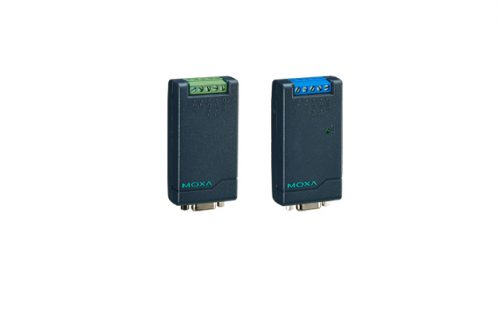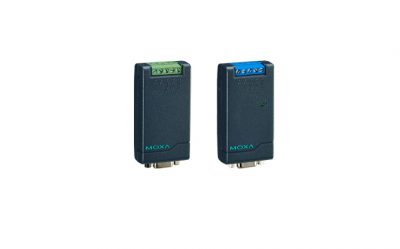TCC-80/TCC-80I
Port-powered RS-232 to RS-422/485 converters with optional 2.5 kV isolation
- Description Specs Details Overview Components Packages Resources Additional Modules Complementary products Architecture Tools Benefits Features Customer Ordering
- Thông số Specs Details Overview Components Packages Resources Additional Modules Complementary products Architecture Tools Benefits Features Customer Ordering
- Ordering Specs Details Overview Components Packages Resources Additional Modules Complementary products Architecture Tools Benefits Features Customer Ordering
- Tài liệu Specs Details Overview Components Packages Resources Additional Modules Complementary products Architecture Tools Benefits Features Customer Ordering
Features and Benefits
- External power source supported but not required
- Compact size
- Converts RS-422, and both 2-wire and 4-wire RS-485
- RS-485 automatic data direction control
- Automatic baudrate detection
- Built-in 120-ohm termination resistors
- 2.5 kV isolation (for TCC-80I only)
- LED port power indicator
Introduction
The TCC-80/80I media converters provide complete signal conversion between RS-232 and RS-422/485, without requiring an external power source. The converters support both half duplex 2-wire RS-485 and full duplex 4-wire RS-422/485, either of which can be converted between RS-232’s TxD and RxD lines. In addition,the TCC-80/80I’s 15 kV ESD protection guards against damage from electrostatic discharge, and the TCC-80I is the world’s first high-speed, port-powered converter with 2.5 kV isolation.
Automatic data direction control is provided for RS-485. In this case, the RS-485 driver is enabled automatically when the circuitry senses the TxD output from the RS-232 signal. This means that no programming effort is required to control the transmission direction of the RS-485 signal. Moreover, the TCC-80I’s patented LED port power indicator lets you check whether or not the TCC-80I is receiving enough power.
Port Power over RS-232
.png) The RS-232 port of the TCC-80/80I is a DB9 female socket that can connect directly to the host PC, with power drawn from the TxD line. Regardless of whether the signal is high or low, the TCC-80/80I can obtain enough power from the data line. However, external power can be used if the handshake line is not available, if the serial cable is too long, or if the RS-232 device is a low power device. For external power, a 5 to 12 VDC power supply can be connected using an adaptor or a USB power cord.
The RS-232 port of the TCC-80/80I is a DB9 female socket that can connect directly to the host PC, with power drawn from the TxD line. Regardless of whether the signal is high or low, the TCC-80/80I can obtain enough power from the data line. However, external power can be used if the handshake line is not available, if the serial cable is too long, or if the RS-232 device is a low power device. For external power, a 5 to 12 VDC power supply can be connected using an adaptor or a USB power cord.
.png)
Port Power Dissipation
When installing a TCC-80 or TCC-80I converter, it is important to pay attention to power consumption, RS-232 cable length, and RS-422/485 transmission distance. In general, the TCC-80 and TCC-80I obtain 50 mW of power from the power source. Standard PC COM ports can provide 70 to 90 mW of power if the TxD, RTS, and DTR lines are connected. Moreover, the RS-232 cable should be shorter than 15 m (@ 9600 bps) to ensure that less power is lost from the host/device to the TCC-80. The remainder of the supplied power is used for transmitting the RS-422/485 signal.
Port Power and Optical Isolation
.png) The RS-232 port of the TCC-80/80I is a DB9 female socket that can connect directly to the host PC, with power drawn from the TxD line. Electrical 2.5 kV isolation for the TCC-80I is achieved with a photo coupler that transforms the electrical signal into light, and then re-transforms the light back into an electrical signal on the other side. In this way, the two electrical circuits are completely isolated from each other. This also protects the devices from ground loop currents, reduces damage caused by data loss, and prevents damage to the communication interfaces.
The RS-232 port of the TCC-80/80I is a DB9 female socket that can connect directly to the host PC, with power drawn from the TxD line. Electrical 2.5 kV isolation for the TCC-80I is achieved with a photo coupler that transforms the electrical signal into light, and then re-transforms the light back into an electrical signal on the other side. In this way, the two electrical circuits are completely isolated from each other. This also protects the devices from ground loop currents, reduces damage caused by data loss, and prevents damage to the communication interfaces.
LED Port Power Indicator
.png) It’s easy enough to test the serial device with a multimeter to determine that the serial device will provide enough power to the media converter. However, it’s even easier to let the TCC-80I test the device for you. Simply connect the TCC-80I to the device’s RS-232 port and set the SW4 switch to Test mode. If the patented port power LED indicator lights up, the TCC-80I is receiving enough power. If the LED does not light up, you will need to attach an external power source to the TCC-80I.
It’s easy enough to test the serial device with a multimeter to determine that the serial device will provide enough power to the media converter. However, it’s even easier to let the TCC-80I test the device for you. Simply connect the TCC-80I to the device’s RS-232 port and set the SW4 switch to Test mode. If the patented port power LED indicator lights up, the TCC-80I is receiving enough power. If the LED does not light up, you will need to attach an external power source to the TCC-80I.
| • RS-232 Side | |
| Connector | DB9 female |
| Signals | RS-232: TxD, RxD, GND (Loop-back wiring: RTS to CTS, DTR to DSR and DCD) |
| • RS-422/485 Side | |
| Connector | Terminal Block or DB9 male |
| Signals | (interface selected by DIP switch) RS-422: TxD+, TxD-, RxD+, RxD-, GND RS-485-4w: TxD+, TxD-, RxD+, RxD-, GND RS-485-2w: Data+, Data-, GND |
| RS-485 Data Direction Control | ADDC® (Automatic Data Direction Control) |
| • Serial Communication | |
| Baudrate | 50 bps to 115.2 kbps |
| Optical Isolation | 2.5 kV rms for 1 minute (TCC-80I only) |
| • Physical Characteristics | |
| Housing | ABS + PC |
| Dimensions | TCC-80/80I: 42 x 80 x 22 mm (1.65 x 3.15 x 0.87 in) TCC-80-DB9/80I-DB9: 42 x 91 x 23.6 mm (1.65 x 3.58 x 0.93 in) |
| Weight | 50 g (0.11 lb) |
| • Environmental Limits | |
| Operating Temperature | 0 to 60°C (32 to 140°F) |
| Storage Temperature | -20 to 75°C (-4 to 167°F) |
| Ambient Relative Humidity | 5 to 95% (non-condensing) |
| • Power Requirements | |
| Source of Input Power | RS-232 port (TxD, RTS, DTR) or power input jack |
| Input Voltage | 5 to 12 VDC |
| Input Current | TCC-80: 10 mA @ 5 VDC (with termination disabled) TCC-80I: 20 mA @ 5 VDC (with termination disabled) |
| • Standards and Certifications | |
| Safety | UL 60950-1 |
| EMC | EN 55032/24 |
| EMI | CISPR 32, FCC Part 15B Class B |
| EMS | EN 61000-4-2 (ESD): Contact: 4 kV; Air: 8 kV EN 61000-4-3 (RS): 80 MHz to 1 GHz: 3 V/m EN 61000-4-4 (EFT): Power: 1 kV EN 61000-4-5 (Surge): Power: 1 kV EN 61000-4-6 (CS): 150 kHz to 80 MHz: 3 V/m EN 61000-4-8 (PFMF) |
| Green Product | RoHS, CRoHS, WEEE |
| • MTBF (mean time between failures) | |
| Time | 2,781,161 hrs |
| Standard | Telcordia (Bellcore), GB |
| • Warranty | |
| Warranty Period | 5 years |
| Details | See www.moxa.com/warranty |
Available Models
| Model No. | Description | |
|---|---|---|
| TCC-80 | Port-powered RS-232 to RS-422/485 converter with 15 KV serial ESD protection and terminal block on the RS-422/485 side | |
| TCC-80-DB9 | Port-powered RS-232 to RS-422/485 converter with 15 KV serial ESD protection and DB9 male connector on the RS-422/485 side | |
| TCC-80I | Port-powered RS-232 to RS-422/485 converter with 15 KV serial ESD protection, terminal block on the RS-422/485 side, and 2.5 KV optical isolation | |
| TCC-80I-DB9 | Port-powered RS-232 to RS-422/485 converter with 15 KV serial ESD protection, DB9 male connector on the RS-422/485 side, and 2.5 KV optical isolation |
Dimensions





